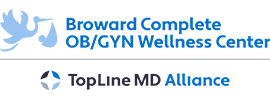Welcoming a new life into the world is a momentous occasion filled with anticipation and excitement. However, for some expectant mothers, the journey through labor may take a different course, marked by what is commonly known as prolonged labor.
In this comprehensive guide, our experts at Broward Complete OB-GYN Wellness Center delve into the intricacies of prolonged labor, exploring its causes, stages, and what every expectant mother should know to navigate this unique aspect of childbirth.
Understanding Prolonged Labor: Unraveling the Basics

Prolonged labor, also referred to as “failure to progress labor,” is a term used to describe a labor process that extends beyond the average duration. Typically, labor is categorized into two stages: the first stage focuses on cervical dilation, and the second stage involves the actual birth of the baby. When either of these stages surpass the expected timeframes, it raises concerns about prolonged labor.
What is Prolonged Labor?
Prolonged labor is generally defined as:
Prolonged First Stage of Labor:
- The first stage involves the initial onset of contractions leading to cervical dilation.
- The prolonged first stage of labor is diagnosed when this phase exceeds 20 hours for first-time mothers and 14 hours for those who have given birth before.
Prolonged Second Stage of Labor:
- The second stage begins with full cervical dilation and continues until the baby is born.
- The prolonged second stage of labor is diagnosed when it extends beyond two hours for first-time mothers and one hour for those with prior childbirth experience.
Causes of Prolonged Labor: Unraveling the Complexities
Understanding the intricate tapestry of factors contributing to prolonged labor involves a comprehensive exploration, as various elements can play pivotal roles in its occurrence.
Physical Factors
Pelvic Structure: The delicate dance between the baby’s head size and the mother’s pelvic opening sets the stage for a smooth or challenging labor. A mismatch in these proportions can impede the baby’s descent through the birth canal, leading to prolonged labor.
Uterine Contractions: The rhythmic ebb and flow of contractions are the orchestra of labor, orchestrating the journey of the baby into the world. However, this choreography can face challenges when contractions are either inadequate in strength or excessively forceful, hindering the natural progression of labor.
Medical Factors
Fetal Distress: The health and well-being of the baby take precedence during labor, and concerns about fetal distress can significantly impact the pace of labor. Healthcare providers may opt for a cautious approach, allowing more time for the baby to navigate the birth canal safely.
Maternal Health Conditions: Pre-existing health conditions can introduce complexities into the labor process. Conditions such as obesity or diabetes may alter the dynamics of labor, necessitating careful monitoring and management to ensure a safe delivery for both mother and baby.
Environmental Factors
External Stressors: The mind-body connection is potent during labor, and external stressors can cast a shadow over the process. High-stress environments, whether stemming from the birthing environment itself or external life factors, can impede the natural progression of labor. Emotional support and a calming atmosphere play pivotal roles in mitigating these stressors.
Interventions
Overuse of Medical Interventions: In the pursuit of ensuring a safe delivery, there can be instances where medical interventions are overused, disrupting the organic flow of labor. Early inductions or unnecessary cesarean sections, while well-intentioned, may inadvertently interfere with the body’s inherent ability to guide the baby through the birthing process.
Navigating Prolonged Labor: What to Expect and How to Cope
Facing prolonged labor is a unique journey that requires emotional resilience and active engagement. Here’s a detailed exploration of how to navigate the challenges and uncertainties associated with prolonged labor:
Emotional Preparedness
Expectant mothers traversing the path of prolonged labor may encounter emotional challenges, and being emotionally prepared is paramount. Understanding that this deviation from the norm is not uncommon can provide a profound sense of reassurance. Open communication with healthcare providers and birthing support teams ensures a collaborative approach to addressing concerns, fostering an environment where emotional well-being is prioritized alongside physical health.
Active Labor Management
Navigating prolonged labor involves active management strategies that focus on monitoring, patience, and the judicious use of interventions.
Monitoring and Evaluation: Continuous monitoring of both the mother and baby’s well-being is paramount during prolonged labor. Regular assessments provide healthcare providers with real-time data to make informed decisions and adjustments as needed.
Patience in the Process: Prolonged labor often demands a watchful waiting approach. Healthcare providers may opt for patience, allowing labor to progress naturally. This approach minimizes unnecessary interventions, promoting the body’s innate ability to guide the baby through the birthing process.
Pain Management
Effective pain management is crucial during prolonged labor, balancing the intensity of the experience with comfort measures and pharmacological options.
Supportive Techniques: Utilizing comfort measures, such as massage, hydrotherapy, or changing positions, becomes instrumental in enhancing the birthing experience. These techniques offer physical relief and emotional support, contributing to a more positive labor environment.
Pharmacological Options: Pain relief options, including epidurals, may be considered to manage discomfort during prolonged labor. Discussing these options with healthcare providers allows expectant mothers to make informed choices aligned with their pain tolerance and birthing preferences.
Informed Decision-Making
Empowering expectant mothers involves providing them with information and involving them in decision-making throughout the labor process.
Understanding Options: Clear and comprehensive information about potential interventions and their implications allows expectant mothers to make informed decisions about their care. This knowledge empowers them to actively participate in shaping their birthing experience.
Consent and Communication: Active participation in decision-making empowers mothers to advocate for their preferences while staying informed about the evolving situation. Consistent communication between healthcare providers and expectant mothers ensures that decisions align with individual birthing plans and overall well-being.
The Role of Supportive Care: Empowering the Birth Experience
Supportive care is instrumental in navigating prolonged labor successfully, providing a foundation of emotional and physical assistance.
Continuous Support: The presence of doulas and birthing partners is invaluable during prolonged labor. These dedicated support persons offer emotional encouragement and practical assistance, contributing to a positive and empowering birthing experience.
Communication with Healthcare Providers: Open dialogue between the expectant mother, her support team, and healthcare providers ensures alignment between desires and recommendations. This collaborative approach fosters a supportive atmosphere where everyone works together towards a common goal—safe and positive childbirth.
Postpartum Care

The journey doesn’t end with the baby’s arrival. Postpartum care is equally crucial in ensuring a smooth transition to motherhood.
Recovery and Emotional Well-being: Attention to physical recovery and emotional well-being post-birth is crucial. Addressing any lingering concerns or emotions related to prolonged labor supports the transition to motherhood, fostering a sense of empowerment and resilience in the face of the unique challenges faced during childbirth.
Conclusion: A Holistic Approach to Prolonged Labor
In conclusion, understanding prolonged labor involves a multifaceted exploration of its causes, stages, and coping strategies. While the term may initially evoke concerns, approaching it with knowledge and a proactive mindset empowers expectant mothers to navigate this unique aspect of childbirth. From emotional preparedness to active labor management and the crucial role of supportive care, a holistic approach ensures a comprehensive and positive birth experience, fostering the well-being of both mother and baby. Through informed decision-making and a collaborative relationship with healthcare providers, expectant mothers can embrace the journey of prolonged labor with confidence, recognizing it as a distinctive chapter in the remarkable story of bringing new life into the world.
That said, if you are looking for a compassionate pregnancy care center in Plantation, Florida, feel free to schedule an appointment with us today.


